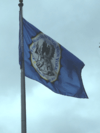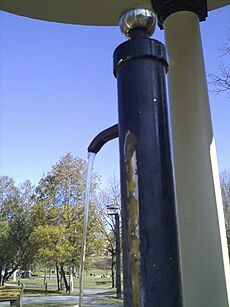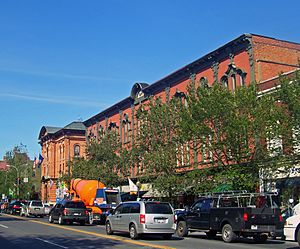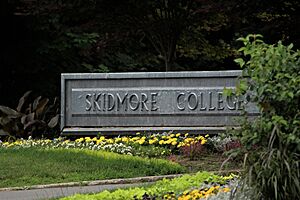Saratoga Springs, New York facts for kids
Quick facts for kids
Saratoga Springs
|
|||
|---|---|---|---|
| City of Saratoga Springs | |||
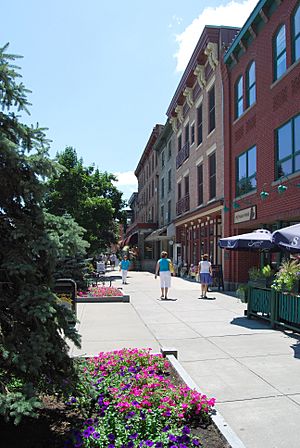
A view of downtown, looking south along Broadway from where it intersects with Caroline Street
|
|||
|
|||
| Nickname(s):
The Spa City, 'Toga, The Springs.
|
|||
| Motto(s):
Health, History, Horses
|
|||
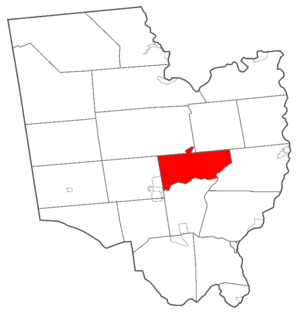
Location of Saratoga Springs within Saratoga County, New York
|
|||
| Country | |||
| State | |||
| County | Saratoga | ||
| Founded | c. 1776 | ||
| Government | |||
| • Type | Mayor-Commission | ||
| Area | |||
| • Total | 28.87 sq mi (74.78 km2) | ||
| • Land | 28.07 sq mi (72.69 km2) | ||
| • Water | 0.81 sq mi (2.09 km2) | ||
| Elevation | 305 ft (93 m) | ||
| Lowest elevation | 0 ft (0 m) | ||
| Population
(2020)
|
|||
| • Total | 28,491 | ||
| • Density | 1,015.18/sq mi (391.97/km2) | ||
| Time zone | UTC−5 (EST) | ||
| • Summer (DST) | UTC−4 (EDT) | ||
| ZIP Codes |
12866
|
||
| Area code(s) | 518 838 | ||
| FIPS code | 36-091-65255 | ||
| FIPS code | 36-65255 | ||
| GNIS feature ID | 964489 | ||
| Wikimedia Commons | Saratoga Springs, New York | ||
Saratoga Springs is a city in Saratoga County, New York, United States. In 2020, about 28,491 people lived there. The city is famous for its mineral springs, which have made it a popular vacation spot for over 200 years. It is also home to the Saratoga Race Course, a place for thoroughbred horse racing, and the Saratoga Performing Arts Center, where you can enjoy music and dance. The city's official saying is "Health, History, and Horses."
Contents
History of Saratoga Springs
The Mohawk Indigenous people once used the area of Saratoga Springs for hunting. They believed the mineral springs were a special gift.
In 1691, the British built Fort Saratoga near the Hudson River. European settlers began to develop the area in the early 1700s. Later, British colonists settled a village called Schuylerville, which was known as Saratoga until 1831.
In 1767, William Johnson, a British officer, was brought to the springs by Native American friends to help heal his war wounds. Johnson was known for his good relationships with the Mohawk and other Iroquois nations.
The first permanent European-American settler built a home around 1776. The springs attracted visitors, and Gideon Putnam built the first hotel for them. Putnam also helped plan the roads and public areas.
The famous Battles of Saratoga during the Revolutionary War did not happen in Saratoga Springs itself. The battlefield is about 15 miles (24 km) to the southeast. A museum about these battles is located there.
Saratoga Springs became a settlement in 1819. It became a village in 1826 and a city in 1915. Tourism grew a lot when the Saratoga and Schenectady Railroad arrived in 1832. This brought many travelers to the famous mineral springs. Large hotels were built to welcome them.
In the 1800s, doctors like Simon Baruch encouraged building European-style spas in the U.S. for health. Saratoga Springs became a popular spa town with many hotels, including the huge Grand Union Hotel.
The Saratoga Race Course opened in 1863. Horse racing and betting made tourism even more popular. The Saratoga Springs area was also known for its gambling places, which later became illegal but were still common. Most of these were near Saratoga Lake.
By 1870, Saratoga Springs was a top fancy resort. It was known for its mineral springs, horse racing, and luxury hotels. During the 1950s, the state and city closed the illegal gambling places. Some large hotels were also torn down, which hurt tourism.
The city became easier to reach when the Adirondack Northway (Interstate 87) was finished. This allowed visitors to travel more easily from the north and south. Also, cultural events like music and dance shows became very popular.
The Famous Mineral Springs
The mineral springs are found along the Saratoga Fault. This fault allows water from deep underground to reach the surface. You can see the fault on the east side of Broadway, especially at High Rock Park.
The Mohawk Indigenous peoples used these springs for hundreds of years before Europeans arrived. Later, people drilled to get more water from the springs. By 1900, there were 203 flowing springs. Some were used to get carbon dioxide and mineral water. This was too much, so in 1908, New York State limited how much water could be taken to let the underground water supply refill. As of 2019, there are only 17 active springs.
To protect the springs, the New York State Reservation (now the Spa State Park) was created in 1911. The Lincoln and Roosevelt bath houses were built there. Today, visitors can still enjoy soaking in the mineral waters at the historic Roosevelt Bathhouse.
The spring water has many minerals like iron, magnesium, calcium, and lithium. Some springs also have radium. People used to believe the springs had healing powers. However, scientists say that drinking the water might not have medicinal benefits because of the high levels of sodium and radium in some springs.
Most springs have small shelters and plaques. Others are just a spigot in a rock. The springs are known for their different tastes. Some are fresh, some are salty, and some taste strongly of certain minerals. There is a sulfur smell, but the water itself has almost no dissolved sulfur. The smell comes from a gas called hydrogen sulfide, which quickly leaves the water. Visitors are welcome to bottle the spring water for themselves.
Geography and Climate
Saratoga Springs covers about 29.1 square miles (75.4 km²). Most of this is land, with a small amount of water.
Major roads like Interstate 87 and US Route 9 pass through or near the city. Saratoga Lake is just south of the city.
Weather in Saratoga Springs
Saratoga Springs has a varied climate. Summers are warm, and winters are cold with a good amount of snow.
| Climate data for Saratoga Springs, New York (1991–2020 normals, extremes 1955–present) | |||||||||||||
|---|---|---|---|---|---|---|---|---|---|---|---|---|---|
| Month | Jan | Feb | Mar | Apr | May | Jun | Jul | Aug | Sep | Oct | Nov | Dec | Year |
| Record high °F (°C) | 67 (19) |
68 (20) |
88 (31) |
92 (33) |
96 (36) |
99 (37) |
99 (37) |
96 (36) |
94 (34) |
88 (31) |
82 (28) |
69 (21) |
99 (37) |
| Mean daily maximum °F (°C) | 32.0 (0.0) |
35.4 (1.9) |
45.3 (7.4) |
60.3 (15.7) |
72.5 (22.5) |
79.9 (26.6) |
83.8 (28.8) |
82.1 (27.8) |
74.9 (23.8) |
62.1 (16.7) |
48.7 (9.3) |
37.0 (2.8) |
59.5 (15.3) |
| Daily mean °F (°C) | 23.1 (−4.9) |
25.7 (−3.5) |
35.1 (1.7) |
48.1 (8.9) |
59.8 (15.4) |
68.0 (20.0) |
72.4 (22.4) |
70.7 (21.5) |
63.3 (17.4) |
51.3 (10.7) |
39.8 (4.3) |
29.3 (−1.5) |
48.9 (9.4) |
| Mean daily minimum °F (°C) | 14.3 (−9.8) |
16.0 (−8.9) |
24.8 (−4.0) |
35.9 (2.2) |
47.0 (8.3) |
56.2 (13.4) |
60.9 (16.1) |
59.4 (15.2) |
51.8 (11.0) |
40.5 (4.7) |
30.8 (−0.7) |
21.6 (−5.8) |
36.3 (2.4) |
| Record low °F (°C) | −33 (−36) |
−29 (−34) |
−13 (−25) |
5 (−15) |
21 (−6) |
32 (0) |
37 (3) |
31 (−1) |
22 (−6) |
2 (−17) |
−1 (−18) |
−23 (−31) |
−33 (−36) |
| Average precipitation inches (mm) | 3.41 (87) |
2.65 (67) |
3.42 (87) |
3.78 (96) |
3.86 (98) |
4.80 (122) |
4.98 (126) |
4.11 (104) |
3.82 (97) |
4.14 (105) |
3.49 (89) |
3.92 (100) |
46.38 (1,178) |
| Average snowfall inches (cm) | 16.5 (42) |
15.7 (40) |
11.4 (29) |
1.8 (4.6) |
0.0 (0.0) |
0.0 (0.0) |
0.0 (0.0) |
0.0 (0.0) |
0.0 (0.0) |
0.1 (0.25) |
2.9 (7.4) |
15.1 (38) |
63.5 (161) |
| Average precipitation days (≥ 0.01 in) | 12.3 | 9.5 | 10.5 | 11.7 | 12.7 | 12.4 | 12.5 | 11.0 | 10.0 | 11.5 | 11.4 | 12.3 | 137.8 |
| Average snowy days (≥ 0.1 in) | 8.2 | 6.9 | 4.7 | 1.2 | 0.0 | 0.0 | 0.0 | 0.0 | 0.0 | 0.1 | 1.8 | 5.7 | 28.6 |
| Source: NOAA | |||||||||||||
People of Saratoga Springs
| Historical population | |||
|---|---|---|---|
| Census | Pop. | %± | |
| 1870 | 7,516 | — | |
| 1880 | 8,423 | 12.1% | |
| 1890 | 11,975 | 42.2% | |
| 1900 | 12,409 | 3.6% | |
| 1910 | 12,693 | 2.3% | |
| 1920 | 13,181 | 3.8% | |
| 1930 | 13,169 | −0.1% | |
| 1940 | 13,705 | 4.1% | |
| 1950 | 15,473 | 12.9% | |
| 1960 | 16,630 | 7.5% | |
| 1970 | 18,845 | 13.3% | |
| 1980 | 23,906 | 26.9% | |
| 1990 | 25,001 | 4.6% | |
| 2000 | 26,186 | 4.7% | |
| 2010 | 26,586 | 1.5% | |
| 2020 | 28,491 | 7.2% | |
| U.S. Decennial Census | |||
In 2012, there were about 26,711 people living in Saratoga Springs. Most people were White (92.5%). Other groups included Black (1.7%), Asian (2.01%), and Native American (0.1%). About 4.0% of the population was Hispanic or Latino.
The average age in the city was 36 years old. About 19.4% of the population was under 18. The median income for a family in 2012 was $114,560.
Economy and Tourism
Tourism is a big part of Saratoga Springs' economy, especially during warmer months. This is when the Saratoga Race Course is open.
The Saratoga Spring Water Co. has been operating since 1872. Their sparkling water has been served at many important events, including presidential inaugurations.
Arts and Culture Scene
The Saratoga Performing Arts Center (SPAC) is a large outdoor theater. It can hold thousands of people for concerts and shows. SPAC is the summer home for the Philadelphia Orchestra and the New York City Ballet. It also hosts a jazz festival every year. The Saratoga Native American Festival is held there each fall.
Museums to Explore
Saratoga Springs has several interesting museums:
- The Tang Teaching Museum and Art Gallery at Skidmore College
- Schick Art Gallery, Skidmore College
- National Museum of Dance and Hall of Fame
- National Museum of Racing and Hall of Fame
- New York State Military Museum And Veterans Research Center
- Saratoga Automobile Museum
- Saratoga Springs History Museum
- Children's Museum of Saratoga
- Saratoga Arts Center
Live Performances
You can find many live performances in Saratoga Springs:
- Theater: Home Made Theater and Saratoga Shakespeare Company.
- Ballet: New York City Ballet at SPAC and Saratoga City Ballet.
- Opera: Opera Saratoga.
- Music: Caffe Lena, Saratoga Performing Arts Center, Saratoga Music Hall, and Universal Preservation Hall.
Historic Places to See
Saratoga Springs has many places listed on the National Register of Historic Places. These include:
- Broadway Historic District
- Canfield Casino and Congress Park
- East Side Historic District
- Saratoga Spa State Park District
- Union Avenue Historic District
- Yaddo
Outdoor Art
Horses Saratoga Style was a public art project in 2002 and 2007. Local artists decorated fiberglass horse sculptures. These were displayed around the city, and some are still there today.
Parks and Recreation
Horse Racing
The Saratoga Race Course opened in 1863. It's a famous place for thoroughbred horse racing.
Saratoga Casino and Raceway is a track for harness racing. It also has a hotel, gaming area, and restaurants.
Sports and Golf
Saratoga Springs is home to the Saratoga Racers basketball team.
There are three public golf courses: Saratoga National Golf, Saratoga Spa Golf, and Airway Meadows Golf Club. There's also a private course, the Saratoga Golf and Polo Club.
Saratoga Spa State Park
The Saratoga Spa State Park is a great place to visit. It has hiking trails, picnic areas, and pools. You can also find historic bathhouses and mineral springs here. The Saratoga Performing Arts Center (SPAC) and several museums are located within the park.
Skateboard Park
The Saratoga Skatepark was built in 1989. It was New York State's first city-run skatepark. It has a concrete "bowl" and ramps. After some changes, the redesigned skate park reopened in 2023.
Education in Saratoga Springs
Empire State College and Skidmore College are both located in Saratoga Springs.
The Saratoga Springs City School District includes:
- Six elementary schools (Kindergarten to 5th grade)
- One middle school (6th to 8th grade) – Maple Avenue Middle School
- One high school (9th to 12th grade) – Saratoga Springs High School
There are also private schools like Saratoga Central Catholic High School and The Waldorf School of Saratoga Springs.
Media and News
Saratoga Springs has several local newspapers and magazines:
- Grid (online newspaper)
- The Saratogian (daily newspaper)
- Saratoga TODAY (weekly newspaper)
- Saratoga Business Journal (bi-weekly newspaper)
- Saratoga Living (quarterly magazine)
Transportation
Saratoga County Airport is located west of the city for general aviation.
Amtrak provides daily train service to Saratoga Springs. You can take the Adirondack to Montreal or New York City. The Ethan Allen Express goes to Rutland, Vermont, and New York City.
Bus services include Greyhound Bus Lines, Adirondack Trailways, and Megabus.
Interstate 87 also runs through the city.
Sister Cities
Saratoga Springs has two sister cities:
 Vichy, France (since 1994)
Vichy, France (since 1994) Waveland, Mississippi (Saratoga Springs helped Waveland after Hurricane Katrina in 2006).
Waveland, Mississippi (Saratoga Springs helped Waveland after Hurricane Katrina in 2006).
See also
 In Spanish: Saratoga Springs (Nueva York) para niños
In Spanish: Saratoga Springs (Nueva York) para niños


